With the Premier League title wrapped up and it’s conclusion approaching, few teams have little to lose, others have everything to play for. Leicester fall into the latter category. A bright start to the season saw the Foxes in the title hunt through the winter months. Since then, a complete change in fortune has seen them slip into a battle for the remaining Champions League positions. Coming into the match Leicester have picked up just nine points from a possible 24 and were in desperate need of a performance in their penultimate match.
Tottenham are in the same category. With no chance of top-flight European football for next season, the North London club have set their sights on the Europa League, which, thanks to Man City’s Carabao Cup victory, is now a possibility. José Mourinho’s men have shown glimpses of excellence mixed with indifference, making this fixture an intriguing spectacle.
In this tactical analysis, we look at how despite dominating the game, Leicester ended up on the wrong side of a humbling 3-0 defeat.
Lineups
The home side reverted back to their favoured 4-2-3-1 shape for this match. During the game, however, this also alternated between a 4-1-4-1 and 4-4-2 as we look at later.
A strong centre-back pairing of Toby Alderweireld and Davidson Sánchez were deployed to operate a deep defensive line, allowing Spurs opportunities to counter in transition. The midfield pairing consisted of Moussa Sissoko and Harry Winks. Despite being a double-pivot, it was Winks who sought the ball more frequently from his defenders, using his technical ability to operate in tight midfield areas and progress the ball through the phases. Alternately, Sissoko used his robustness and athleticism to protect his back four and challenge for second balls in the central spaces.The attacking unit was made up of Giovani Lo Celso, who played a dynamic role in between the lines, looking to link attacks by finding pockets of space amidst Leicester’s defensive structure. The wide players were Brazillian Lucas and Heung Min-Son. Rather than operate as traditional wingers, the pair played as inside-forwards, closing the distance between themselves and Harry Kane up front. This enabled cohesiveness in the attacking unit as they transitioned quickly. This movement inside also allowed Ben Davies and Serge Aurier to advance forward in the lateral spaces.
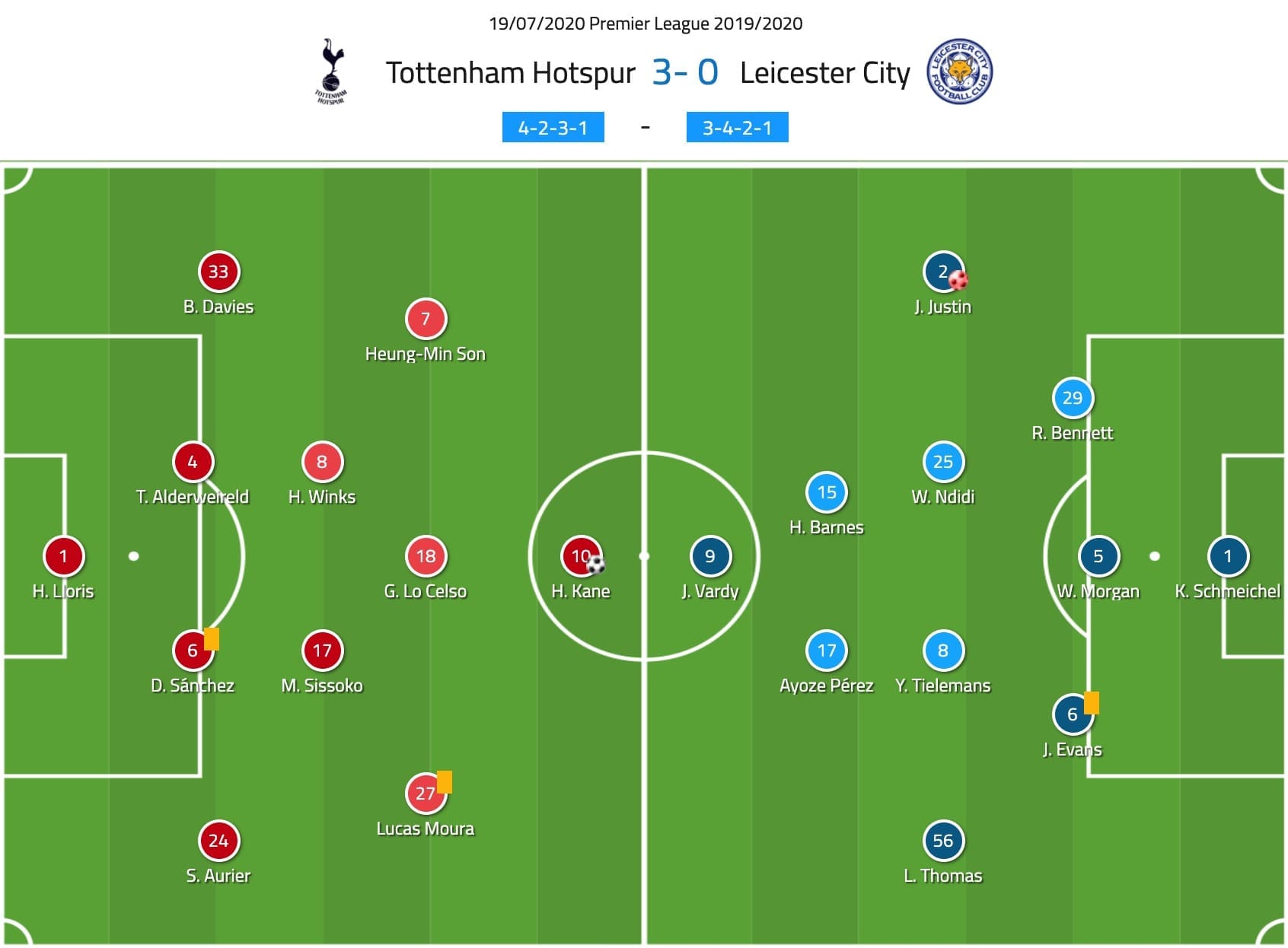
Brendan Rogers’ side were unfortunately depleted in what turned out to be a torrid afternoon for his side. Absentees, Çağlar Söyüncü, Ben Chilwell and Ricardo Pereira gave starts to Ryan Bennett, who struggled on the right of a centre-back trio. Youngsters Luke Thomas and James Justin started as the wing-backs in a fluid 3-4-2-1 system that shifted depending on the phase of possession Leicester were in.Youri Tielemans and Wilfred Ndidi were the double-pivot in midfield. The pair dropped deeper to collect the ball from their centre-backs, releasing the wing-backs higher up the field. This movement created a 5-man system to progress passes through the phases, which Spurs struggled to handle.The attacking outlet consisted of Jamie Vardy, whose lively movement was thwarted somewhat by a deep defensive line. Consequently, however, this depth opened spaces for Harvey Barnes and Ayoze Pérez to operate in support. The pair picked up a lot of the ball in the half-spaces but were restricted to safer lateral passes due to the congestion in the central zones.
Tactical narrative – A coiled spring
Not often in a 3-0 home victory do you confidently say the scoreline was flattering. Despite Kane’s undoubted brilliance in from of goal, Tottenham managed just seven shots, scoring three of them. Compared to Leicester’s 20, we can already get a sense of the game dynamics.
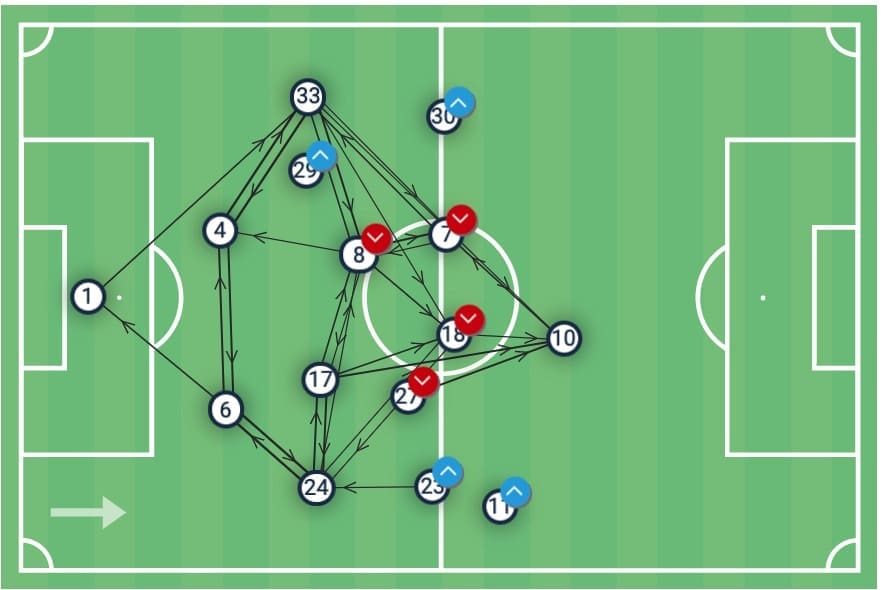
Looking at the Tottenham pass map we can immediately see from the lack of strong combinations that the tactics in preference of containment over offensive fluidity. The home side attempted just 261 passes compared to Leicester’s 651, highlighting their tactical emphasis on shape and controlling the game out of possession. To highlight this further, Spurs averaged a PPDA of 18.1.
Notice the narrowness of Lucas (27) and Son (7), who took up much more effective positions for transitioning, which prevented Kane from becoming isolated.
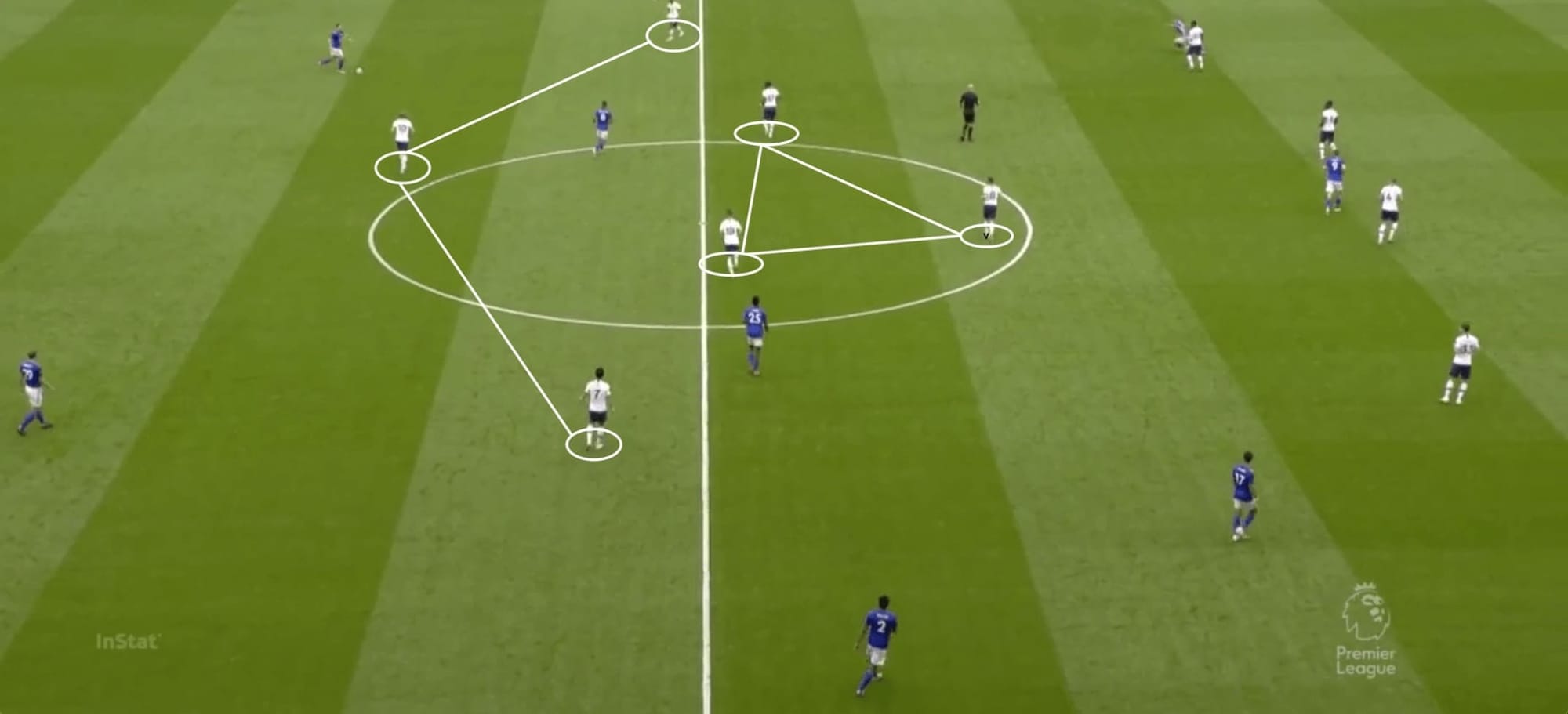
Out of possession Spurs were quick to fall into a set 4-1-4-1 shape, especially in the earlier phases of Leicester’s build-up. As you can see, Winks dropped his positioning into a deeper role. This meant he could use his mobility and positional awareness to cover passing lanes in the centre of the pitch as well as support in the lateral spaces when flanks were committed to in attack. Notice Lo Celso dropping into Wink’s original position to maintain the rigid shape.
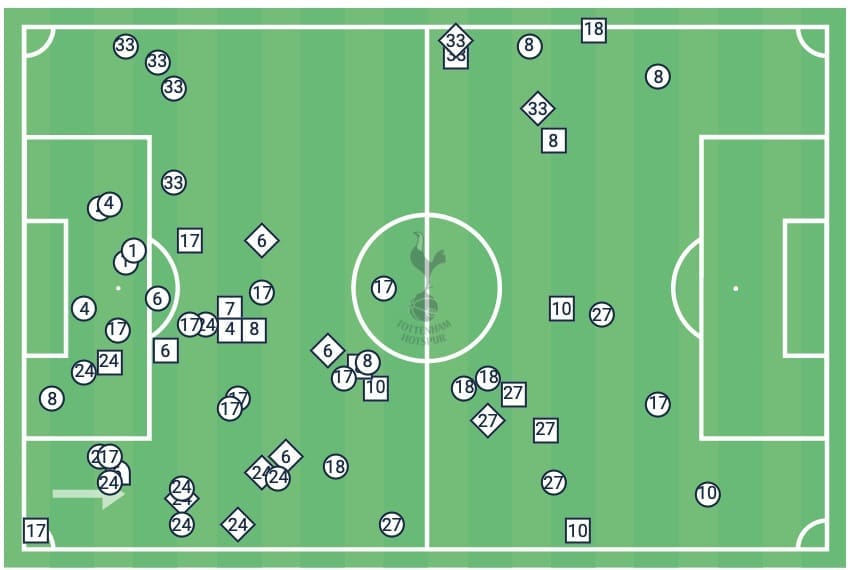
We can see from the visual above that the majority (59%) of Tottenham’s recoveries occurred in their defensive third. Not only did this stifle Leicester in attack but also created the space for counter-attacking, which we look at next.
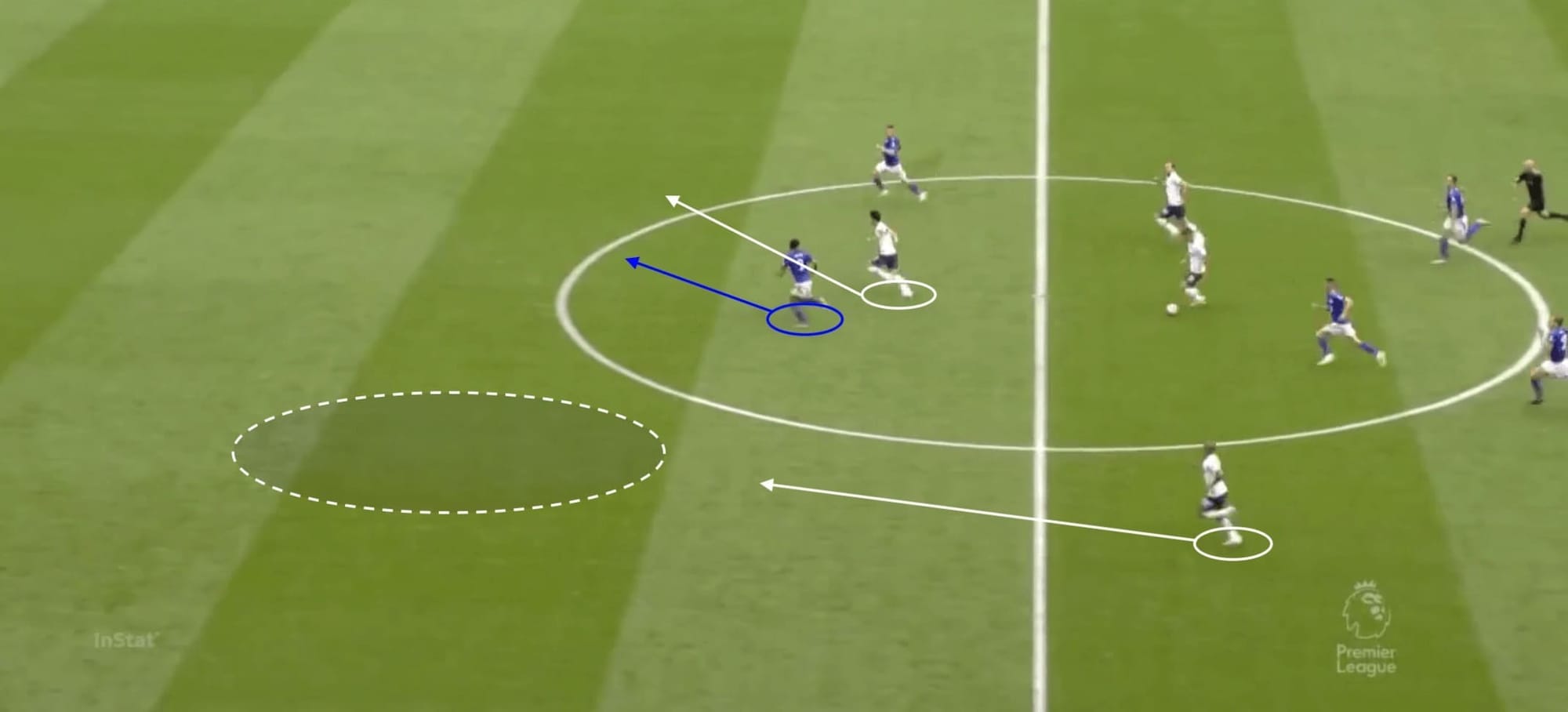
Because of their defensive tactics, Tottenham didn’t really have sustained periods of attack. Instead, they relied on fast attacking transitions and committed enough players to these breaks, causing Leicester a problem in defensive transition.
Above we can see a phase of play leading to Tottenham’s second goal. A deep recovery was made following a Leicester corner and rather than playing an early direct pass, which would distance the attacking unit – making it harder to knit attacks together – Tottenham break in numbers using progressive dribbling instead to drive through the phases of the pitch. Notice the clever run from Son to open space for Lucas on the left-wing.
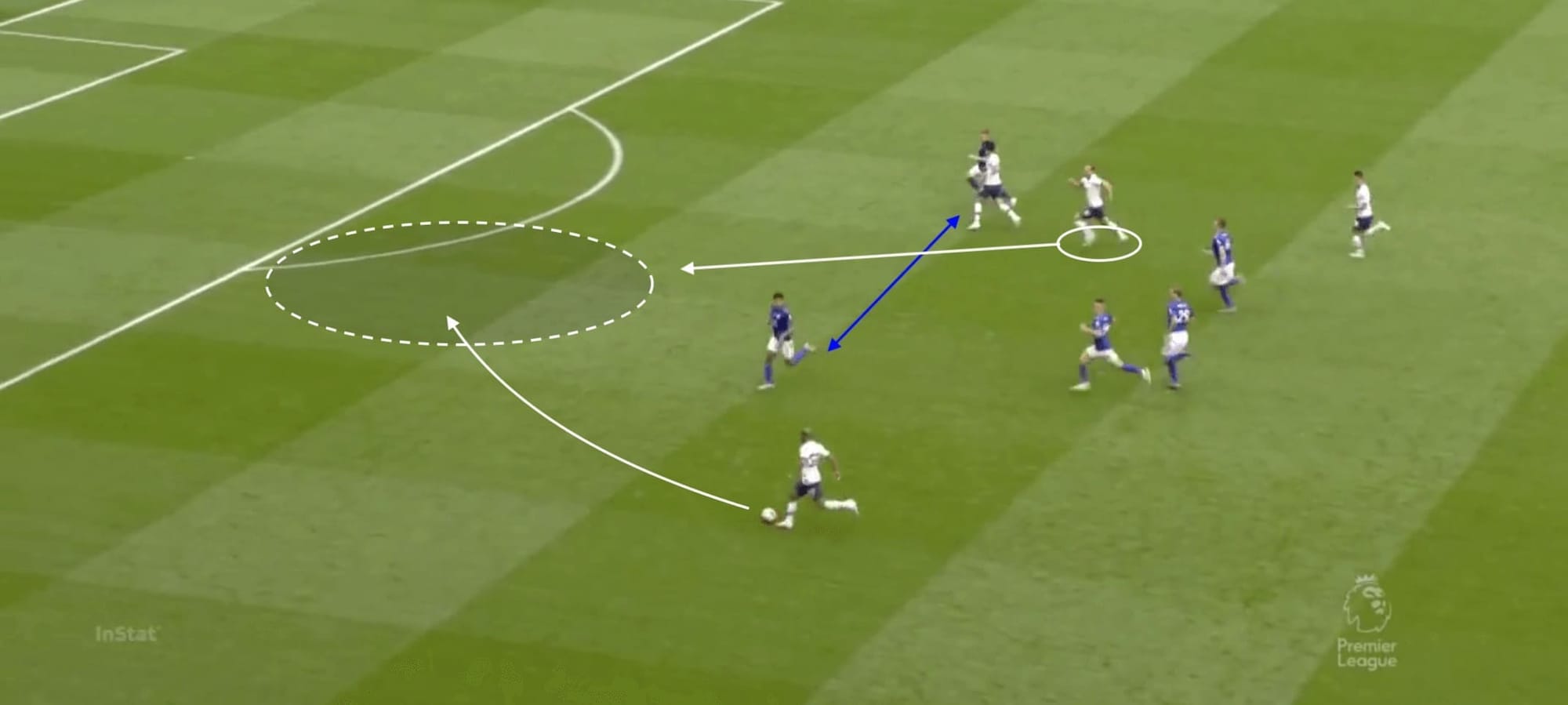
The pass is made into Lucas who is now in open space. The defender is forced to come across, which thanks to the numbers in support for Spurs, distances him from his fellow centre-back. Kane notices this and makes a penetrative dart through the centre, latching onto a nice through pass and finishing clinically past Kasper Schmeichel.
The early deflected goal allowed Tottenham to flourish using these tactics as Leicester pushed forward looking to get back into the match. No statistic highlights this more than 75% of counter-attacks ending in a shot for the home side.
Next, we take a look at the visitor’s approach to the match.
A bad trip to the capital
There was a stark difference in how the two teams approached this game. Rogers continued in his fluid pro-football manner, looking to weave passes and create interchanges all in the hope of penetrating the home side’s defensive structure.
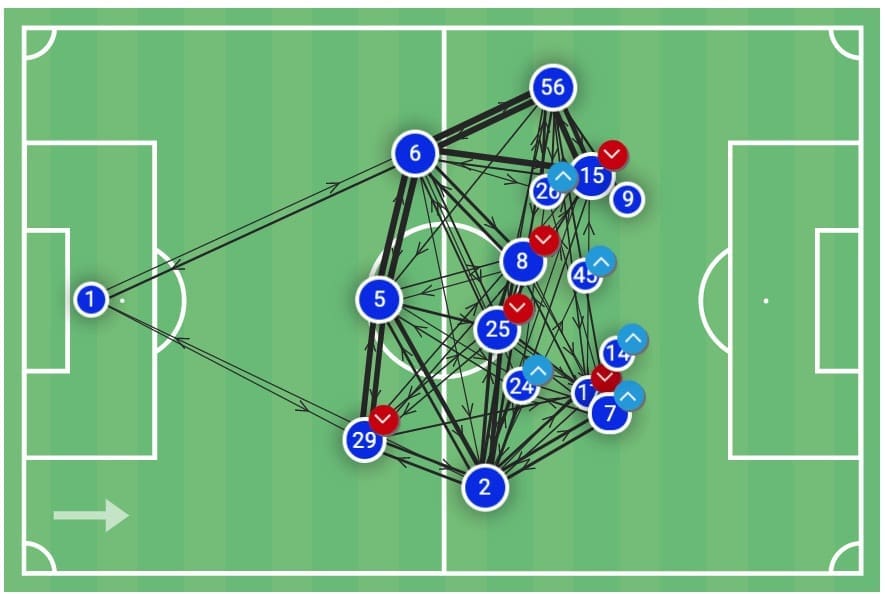
Out of possession, the Foxes were aggressive. Averaging a PPDA of 7.21 the visitors looked to press their opponents high up the pitch in order to recover the ball in dangerous areas. We can see from the average positions above how high the line of Leicester was; this allowed the team to press as a unit and not leave large vertical spaces between the lines. Despite this aggressive tactic providing the opportunity for positive recoveries, it also offered counter opportunities to Spurs as Wes Morgan, Jhonny Evans and Bennett all lacked the pace to cope effectively in defensive transition.
In possession Leicester were good. The visitors were able to build-up from the back using their double pivot and centre-back trio to identify an open man in midfield, allowing progression through the pitch. This was also heavily assisted by the space being sacrificed by Tottenham in their attempts to drop into a lower block.
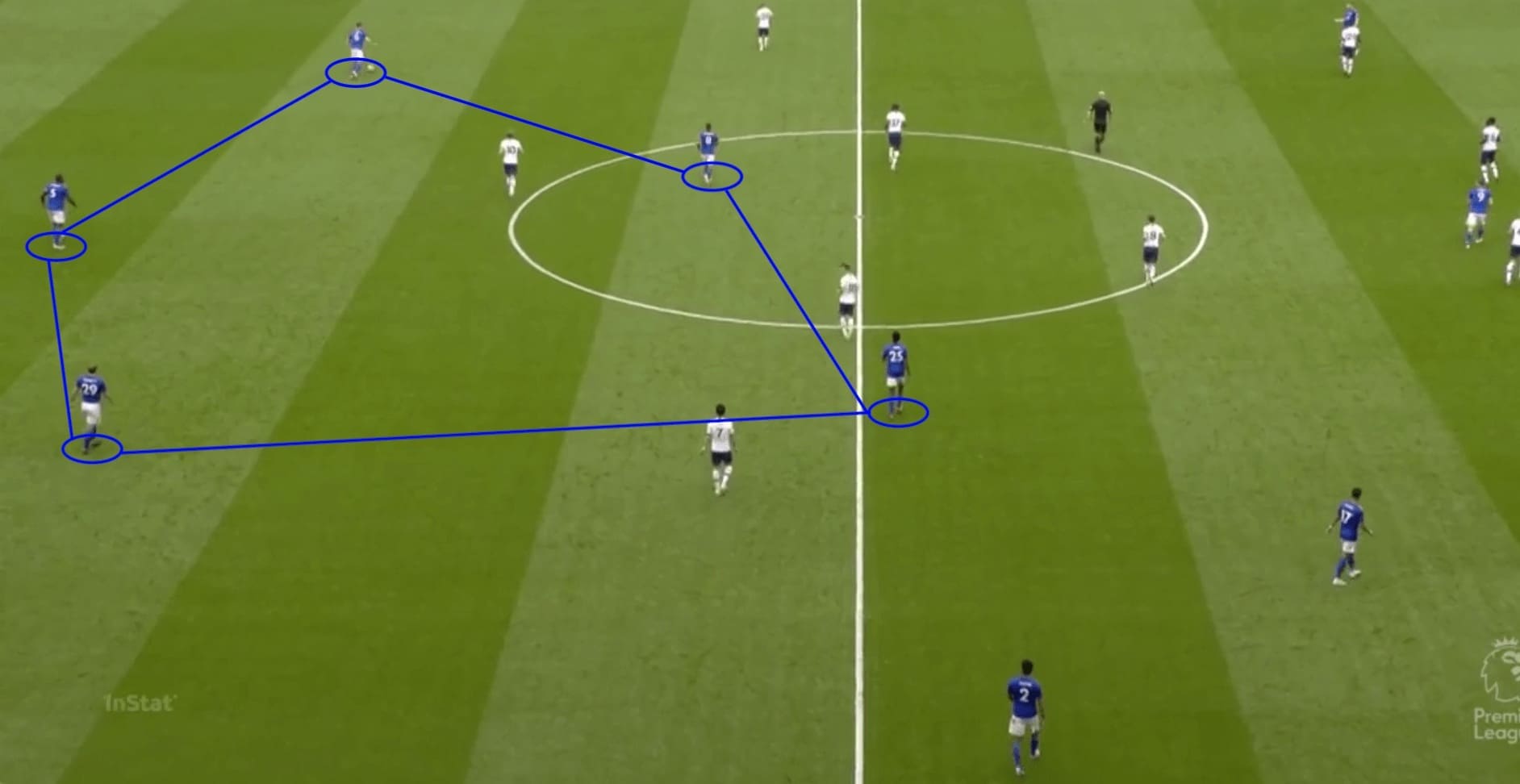
At this stage in established possession, Leicester moved their wing-backs higher up the pitch to join the midfield line. This offered width to the team and pulled open gaps in the half-spaces for Barnes and Pérez to cause Tottenham difficultly. The next sequence demonstrates this clearly.
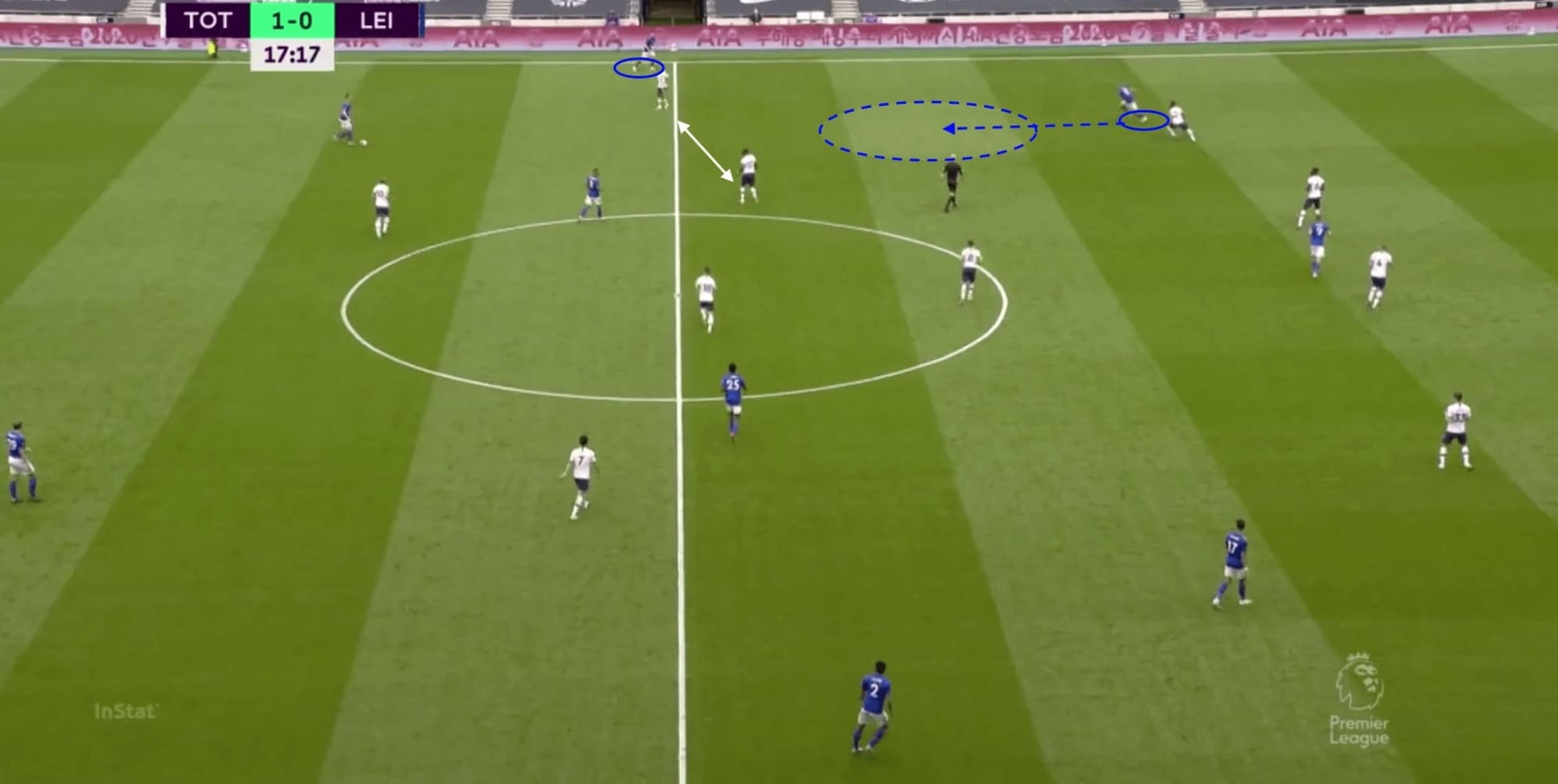
Once Leicester’s wing-backs established their position in the second phase, Lucas is forced wide to block the passing lane into the advancing defender. This movement opens space between him and Sissoko, as we can see above. Barnes, on this occasion, is the man in the half-space who notices the open channel. He makes a darting movement into the space (highlighted).
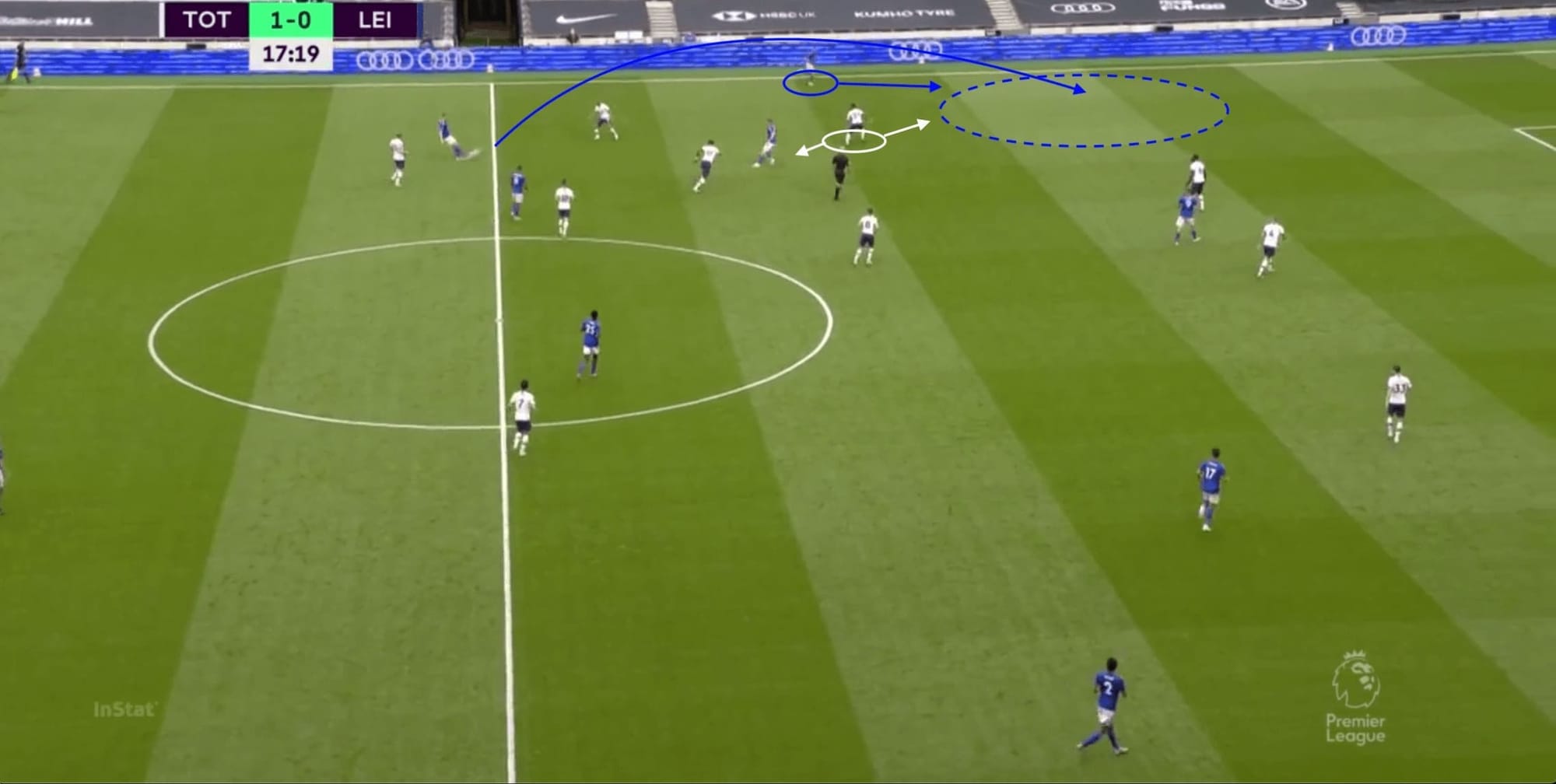
Because of his original positioning, Aurier is already touch tight with Barnes, but narrow as a result. To prevent an easy pass through the lines, Aurier follows Barnes into the space, opening up space in behind for the Leicester wing-back. Evans is then able to pick out a simple lifted pass to penetrate Tottenham.
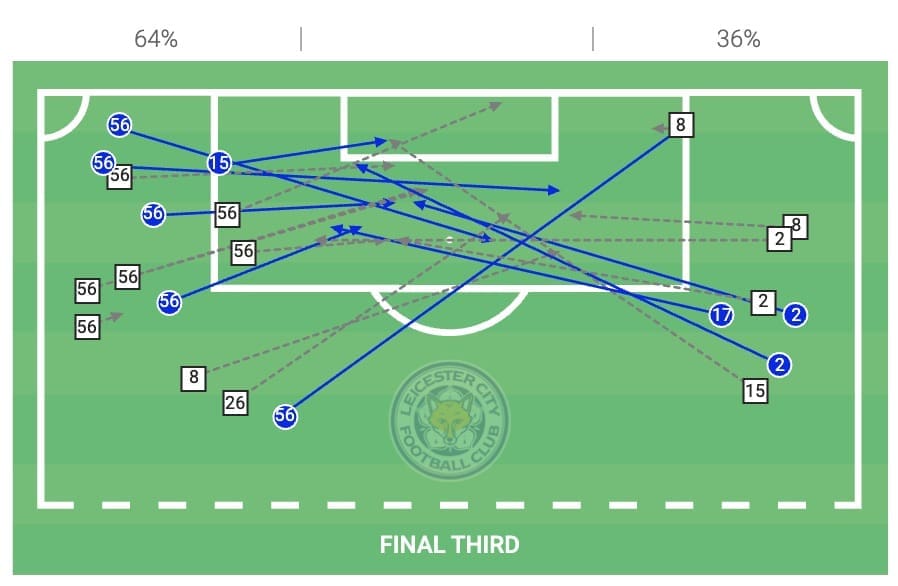
As you can see above, this combination occurred a lot for Leicester allowing them to penetrate in the wide areas. In emphasis of the weakness identified, 64% came from the left, with Thomas (56) attempting 11 crosses in total. However, they were unable to take advantage of the 22 crossing opportunities they created.
Despite their prowess in the build-up phase, Leicester were unable to breach Hugo Lloris’ goal. The visitors will leave disappointed after creating so many chances. Below we look deeper into the expected goals figures for the Foxes.
Unlucky or unselective?
If you looked at the stats following the game without looking at the score, you would have bet that Leicester walked away victorious. A higher xG 2.02 to Tottenham’s 1.2, more possession, more corners all tell a story of the match dynamic but don’t necessarily tell the whole story. To understand whether a team is unlucky we need to look at the xPTS.
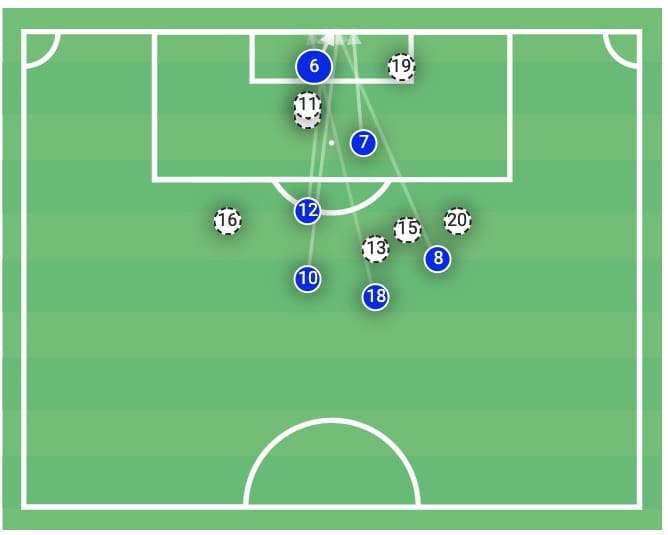
Above is Leicester’s shot map displaying the 22 shots which amassed an xG of 2.02 as mentioned. This xG figure was reached with a number of opportunities ranging from Vardy’s 0.76 effort from a few yards out to Barnes’ 0.12 effort from range.
As discussed in a previous analysis article, amassing a big xG is great, but how you do it also makes a difference to the result over an infinite amount of games. I ran the same tests from that article to this to arrive at the xPTS in order to see whether Leicester are shooting too frequently.
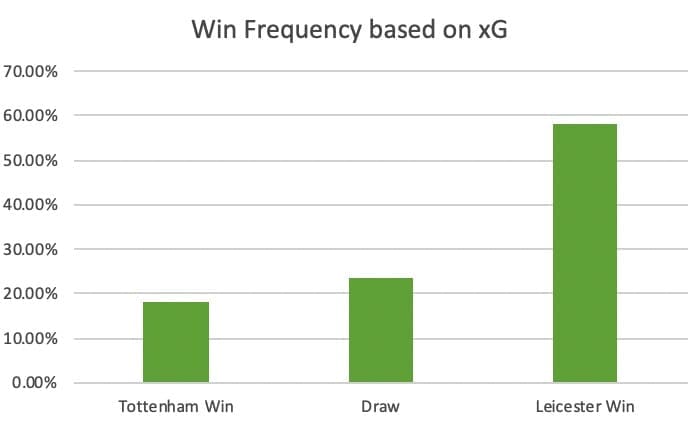
The results are clear. Leicester can consider themselves unfortunate not to have taken more from the game. The xG figures tell us that based on these statistics, Tottenham would expect to win the game just 18.25% of the time and draw 23.69% with identical chances. Leicester based on their chances would expect to win a whopping 59.06% of the time, something Rogers will no doubt lament on the coach back to the midlands.
Closing thoughts
Despite the statistics saying otherwise, Tottenham won the game. Another win on the resume of Mourinho has them moving in the right direction and in a results-driven world, keeps the fans happy. As a neutral party, I am still unconvinced by the new-look Spurs. Despite continuously picking up points to pave over some cracks, I still see a team whose performances and results don’t yet gel. All the time winning continues an eyelid won’t flicker, however, take three points out the equation and this side (currently) doesn’t have performances to fall back on.
On top of bad luck and individual errors, the absence of key players has caught up with Roger’s side. What was a dynamic back five at the start of the season has turned into a sluggish, disorganised unit that is struggling to contribute in the attacking phase as well as keep goals out. Leicester are now in what is essentially a cup final with Man United in their final game of the season. The terms and conditions are yet to be set and will remain unknown until the final whistle blows at Old Trafford on Wednesday, either way, Leicester must be ready.





Comments